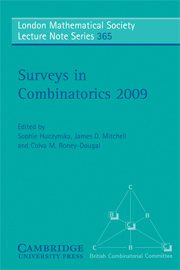Book contents
- Frontmatter
- Contents
- Preface
- 1 Graph decompositions and symmetry
- 2 Combinatorics of optimal designs
- 3 Regularity and the spectra of graphs
- 4 Trades and t-designs
- 5 Extremal graph packing problems: Ore-type versus Dirac-type
- 6 Embedding large subgraphs into dense graphs
- 7 Counting planar graphs and related families of graphs
- 8 Metrics for sparse graphs
- 9 Recent results on chromatic and flow roots of graphs and matroids
7 - Counting planar graphs and related families of graphs
Published online by Cambridge University Press: 05 May 2013
- Frontmatter
- Contents
- Preface
- 1 Graph decompositions and symmetry
- 2 Combinatorics of optimal designs
- 3 Regularity and the spectra of graphs
- 4 Trades and t-designs
- 5 Extremal graph packing problems: Ore-type versus Dirac-type
- 6 Embedding large subgraphs into dense graphs
- 7 Counting planar graphs and related families of graphs
- 8 Metrics for sparse graphs
- 9 Recent results on chromatic and flow roots of graphs and matroids
Summary
Abstract
In this article we survey recent results on the asymptotic enumeration of planar graphs and, more generally, graphs embeddable in a fixed surface and graphs defined in terms of excluded minors. We also discuss in detail properties of random planar graphs, such as the number of edges, the degree distribution or the size of the largest k-connected component. Most of the results we present use generating functions and analytic tools.
Introduction
We consider planar graphs as combinatorial objects, regardless of how many different embeddings they may have in the plane. Let gn be the number of labelled planar graphs with n vertices, and let Rn be a graph taken uniformly at random among all gn labelled planar graphs with n vertices. The main questions we are interested in are the following.
(1) How large is gn asymptotically?
(2) Which are the typical properties of Rn for n large?
(3) What can be said about related families of graphs?
As we are going to see, we have a complete answer to question (1), and significant results concerning (2) and (3). A precise estimate for gn was obtained by the present authors [38], together with the derivation of limit laws for the basic parameters in random planar graphs. The techniques introduced in [38] have been applied to the analysis of other classes of graphs [12, 35], to the analysis of more advanced parameters [24, 25, 39], and to the uniform sampling of planar graphs [30].
- Type
- Chapter
- Information
- Surveys in Combinatorics 2009 , pp. 169 - 210Publisher: Cambridge University PressPrint publication year: 2009
- 3
- Cited by



